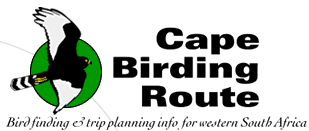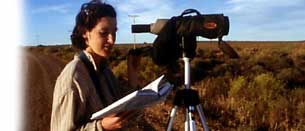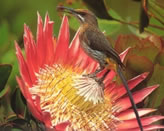Pofadder
Area
Pofadder,
the stereotypical South African one-horse town, bears the
name of the Puffadder (Bitis ariens), a sluggish and
highly toxic snake found throughout South Africa. Acacia
Pied Barbet, Red-eyed Bulbul and Pale-winged
Starling occur in the town itself. The giant nests of
Sociable Weaver
are common in this part of Bushmanland. A particularly picturesque
assemblage of these nests, with a resident pair of Pygmy
Falcon (p.110), is found in some camelthorn trees
exactly 11 km east of Pofadder (1 on map below).
The
50-km unsurfaced road that leads from Pofadder to the Orange
River at Onseepkans offers excellent birding across a diversity
of habitats, from arid rocky gorges and dusty plains to lush
riparian vegetation. The large-billed subspecies of Sabota
Lark (see p.13), Karoo Long-billed Lark and Karoo
Chat are common along the first section of this road.
The acacia-lined watercourse (2) crossing the road (6.3 km
from Pofadder) contains Acacia Pied Barbet and Pririt
Batis. After 15 km from Pofadder (from 3 onwards),
check the open plains for Burchell’s
Courser (p.96*) and Stark’s Lark, and
after 20 km look for Scimitar-billed Woodhoopoe, Sabota
and Fawn-coloured Larks in the low thorn-trees on the
right-hand side. Thirty-three kilometres from Pofadder, a
beautiful gorge falls away on the left of the road: look here
for Short-toed Rock Thrush (scarce; see also p.124)
Cinnamon-breasted
Warbler (p.85*), Pale-winged Starling, Dusky
Sunbird and Black-headed Canary (p.105*). As you
reach the first buildings of the hamlet and border post of
Onseepkans, check the group of palms on your right for breeding
Rosy-faced Lovebirds (an extremely localized bird in
South Africa) and Palm Swifts. African Fish Eagle
and Darter frequent the river. The riparian vegetation
offers Swallow-tailed Bee-eater, Cape Reed Warbler,
African Marsh Warbler (summer), Namaqua
Warbler (p.85*), Red-billed Quelea and Red
Bishop. The peachy-flanked subspecies of Cape White-eye
(p.13) is common here, as is Black-throated Canary.
Fan-tailed Cisticola display over the agricultural
fields close to the Orange River.
From
Pofadder, take the gravel road to the southwest, towards Namies.
[This is the P2961 (not the R358), and can be reached by turning
into Buitenkant Street (on the western edge of the town) from
the N12. At the T-junction with Springbok Street, turn right
and follow this road, which becomes gravel after a short while.
Continue along the gravel and turn left into the P2961 after
0.3 km.] At 4 (see map, previous page), search the open plains,
and check the water trough at 5 for Sclater’s
Lark. At dawn and dusk, listen for the frog-like duet
of the Karoo Korhaan, one of the characteristic sounds
of South Africa’s arid plains. Continue through the Namies
mountains, where Cinnamon-breasted
Warbler occurs on the rocky slopes at 6 and 7. Be
particularly careful when driving on the unsurfaced road in
this vicinity, as there are a number of treacherously sharp
corners. Sabota Lark (see p.13) and Karoo Long-billed
Lark are common; look for the former in the taller scrub,
where it draws attention to itself with its canary-like song.
Also look out for overflying Bradfield’s Swifts.
At night, listen for the deep hoot of the Cape
Eagle Owl (p.105*), which is resident on the slopes
here, especially in the vicinity of the Ghaamsberg (8). This
mountain is a treasure chest of biological diversity and threatened
plants; sadly, the proposal to build the world’s largest
open-cast zinc mine on its summit seems set to go ahead. Check
the water troughs at 9 for large numbers of drinking Namaqua
Sandgrouse and Lark-like Bunting. Continue to 0,
where the road is crossed by intensely red dunes, and there
is a stock enclosure lined with tyres on each side of the
road. The dunefield is surrounded by sparsely-grassed and
mesmerizingly flat expanses, punctuated by the occasional
mountain. This is a well-known site for the richly-coloured
dune form of Red Lark,
which is in fact one of the most common birds in the vicinity.
The larks are most easily found in the morning and late afternoon,
when their rattling calls drifts across the dune crests. Between
bouts of calling from the dune scrub, they feed on the ground,
and can usually be seen running about between the bushes.
Other common birds here include Grey-backed Finchlark,
Scaly-feathered Finch, and Anteating Chat. Fawn-coloured
Lark occurs less frequently. From 0, either retrace your
steps to 9 and turn left towards the tarred N14 near the mining
town of Aggenys (note that there is no accommodation available
here) or, if well prepared with fuel and water, continue along
the scenic gravel road to Springbok via Gamoep (see p.102).
The
first 15 km or so of this road will prove rewarding for Karoo
and Northern Black Korhaans; also check carefully for
Sclater’s
and Stark’s Larks.
If
you have a spotlight, it is always worth taking a night drive
along remote gravel roads: Rufous-cheeked Nightjar
is common on the plains in summer, and Cape
Eagle Owl may sometimes be seen near rocky areas.
The Bushmanland also has an exciting diversity of nocturnal
mammals (see box, p.124). Aardvark (Orycteropus afer),
whose deep burrows can be seen throughout the region, is occasionally
observed on night drives in Bushmanland. Other common mammals
are Springhare (Pedetes capensis) and Bat-eared Fox
(Otocyon megalotis); sadly, the latter is a regular
road casualty.
|


